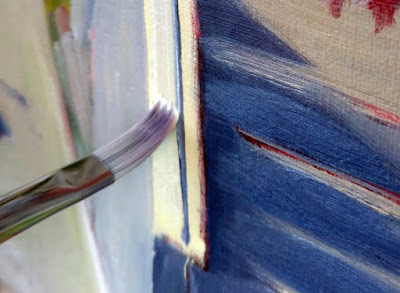Our leaders need to hear how much we support art… and how art supports us.
 |
| Ocean Park Beach Erosion, by Carol L. Douglas |
On Monday morning, I will drag David Blanchard out at 6:30 AM to ride with me to Augusta. Dave is the organizer of the new Knox County Art Society and one of nine regional coordinators for Plein Air Painters of Maine (PAPME). He’s coming with me to the first
Arts + Culture Day to show our legislators just how much the arts mean to our state.
You don’t have to get up that early, but I’d like it if you’d join us. The event runs from 9 AM to 11:30 AM at the Maine State House Hall of Flags. It’s free and open to the public, and there’s lots of free parking in the area.
This is a new legislature and a new administration, and we want them to know how seriously we support art, and how art supports us. It’s an opportunity to strengthen relationships between arts leaders and public officials and to discuss cultural policy here in our state. Your voice and your face, are needed.
 |
| Clary Hill Blueberry Barrens, by Carol L. Douglas |
But all work and no play makes Jack a dull boy. There will be performances and presentations through the program, and many cultural organizations from across the state will be represented.
I’ll be there representing plein air painting. PAPME has about 600 members, about three-quarters of whom are Maine residents. The majority show and sell their work in commercial galleries, festivals and plein air events.
Members meet weekly in different locations around the state to paint. There are no dues and no activity requirements. Currently, there are nine chapters statewide. More are always welcome.
There are around 150 commercial art galleries in the state of Maine. The painters dotting the landscape and the galleries that represent them are key attractions to visitors to our state.
 |
| Sea Fog, by Carol L. Douglas |
Arts and culture are a recognized regional development driver, one that Maine has exploited successfully. Rockland is a great success story, but it’s not the only one. Too often, public officials think of art as a luxury, but it’s serious business. The arts in America contribute more than $800 billion a year to our economy. That’s around 4% of our Gross Domestic Product (GDP).
There is a myth that artists congregate in big cities. These may have the highest density of artists, but many artists are attracted to rural living, especially in Maine. Artists like affordable housing, vibrant art scenes, educated communities, and access to markets for their art.
Because art is handmade, it is tied to the place it’s created. That means art can’t be outsourced. An artist is unlikely to leave for another state because the Economic Development people offer him a better deal.
If you’re an artist, a fan of art, or someone interested in economic development, your presence on Monday is vital.
 |
| Snow at higher elevations, by Carol L. Douglas |
The State House is located on the corners of Capitol and State Streets in Augusta. The west entrance, facing the Cross Office Building, is open to the public.
To get there from I-95 get off at exit 109 and travel east on route 202 (Western Avenue). Continue to the first rotary where you take the first possible right turn onto State Street. Proceed to the traffic light where you will see the State House in front of you on the right. Turn right at the light onto Capitol Street for access to parking behind the Cross Office Building or in the Sewall Street garage. Parking may also be available south of the State House, behind the State Library, Archives and Museum building.
















































